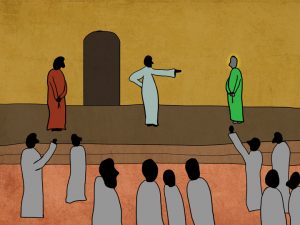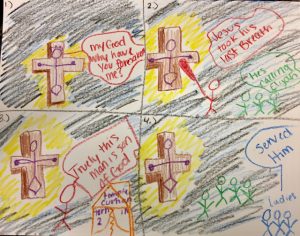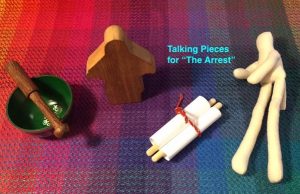
There were fourteen of us today in our “Sacred Stories” Circle of the Word. Twelve of the participants were women residing in the jail. Susan Bennett and I were the Circlekeepers. We pretty much filled the room.
The story for the day was Jesus before Pilate. Sometimes I call it “The Trial Before Pilate,” sometimes just “The Sentencing.” I begin by paraphrasing all the stories we have done in the “Journey to Resurrection” series, starting with “The Anointing” from Mark 14. I put graphics along the edge of our Circle to highlight the sequence of episodes.
When I came to last week’s story about Peter’s denial, I kept mixing up Jesus and Peter. For example, after the council condemns Jesus, I said that Jesus was down in the courtyard (Peter was there, not Jesus). Thankfully, Susan corrected me so I wouldn’t have everyone totally confused.
Then, when I said the slave-girl three times identified Peter as one of Jesus’ supporters, one of the women corrected me. She pointed out that the slave-girl identified Peter twice, but the bystanders did it the third time. I was very impressed at how thoroughly she had learned “Peter’s Denial” last week.
In today’s story, the crowd shouts vehemently, “Crucify him!” It’s hard to tell and painful to hear. Nevertheless, everyone listened. It was an unusually attentive group. Maybe that’s because these stories connect with the women’s own experience of betrayal, arrest, interrogation, trial, sentencing, and imprisonment. They could no doubt relate to how Jesus was handed over from one authority to the next.
Susan led the Word I Heard activity. The words and phrases we offered after hearing the story a second time pretty much covered all its episodes. After Susan read these off at the end of the activity and commented on how much of the story we had covered the woman next to her said, “We listened well.”
This observation and affirmation of the group effort was both accurate and heart-warming. More than that, the comment emphasized the value of the gift of good listening. The women listen well to each other, to the storyteller, and to the Word of God. In prayer, they trust that God will listen well to them. That is one way of practicing faith.







